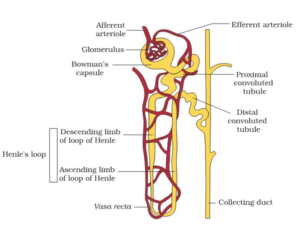Excretory Products and Their Elimination MCQ/Objective Questions Biology Chapter 19
Which among these is not a waste:
- a. Glucose
- b. Carbon dioxide
- c. Urea
- d. Ammonia
Which is most toxic waste
- a. Uric acid
- b. Urea
- c. Nitrogen
- d. Ammonia
In context of mode of exertion, humans are
- a. Ammonotelic
- b. Ureotelic
- c. Uricotelic
- d. None
Which among these have protonephridia or flames cells for excretion of wate materials?
- a. Platyhelminths e.g. planaria
- b. Earthworms and annelids
- c. Chephalochoradtes e.g. amphioxus
- d. a and c
Organ for excretion in mammals is
- a. Protonephridia
- b. Nephridia
- c. Malpighian tubule
- d. A pair of kidneys
Antennal gland or green glands are the organs of excretion in:
- a. Cockroach
- b. Hydra
- c. Planaria
- d. Prawns
Which one among these is not a part of the nephron?
- a. Glomerulus
- b. Renal tubule
- c. Collecting duct
- d. None
How many nephrons are there in a kidney?
- a. 1million
- b. 10k
- c. 1K
- d. None
Following is absorbed actively in the kidney
- a. Na+
- b. K+
- c. Glucose
- d. Urea
A capsule like shape present in nephron is
- a. Joint capsule
- b. Bowman’s capsule
- c. Nephridia
- d. Malpighian tubule
Glomerular filtration rate (GFR) in a healthy individual is approx
- a. 250ml/min
- b. 125ml/min
- c. 75ml/min
- d. 25ml/min
Which part of nephron actively secrete hydrogen, ammonia and possium ions and reabsorbs bicarbonate ion and water

- a. PCT
- b. DCT
- c. Loop of Henle
- d. Collecting duct
Loop of Henle is
- a. Permeable to water
- b. Impermeable to electrolyte
- c. Permeable to electrolyte
- d. a nd b
Place for Conditional reabsorpyion of NA+ and water is
- a. PCT
- b. DCT
- c. LH
- d. Collecting duct
The special arrangement of Henle’s loop and vasa recta in the nephrone is
- a. Direct current mechanism
- b. Countercurrent mechanism
- c. Osmosis
- d. None
Hormone that regulate kidney function is
- a. renin-angiotensin
- b. Thyroid
- c. Insulin
- d. None
which organ among these do not have any role in excretion
- a. Skin
- b. Lungs
- c. Heart
- d. Kidney
The process of artificial removal of nirogenous waste from blood using dialyser is:
- a. Coagulation
- b. Dialysis
- c. Degluttination
- d. None
See also:
Excretory Products and Their Elimination MCQ/Objective Questions Biology Chapter 19
Ref: Ch 19.